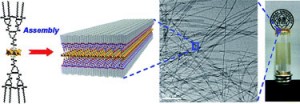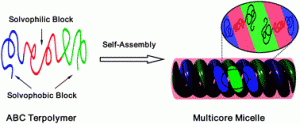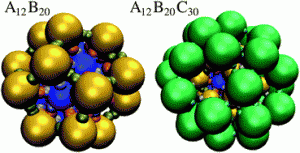 Polyoxometalate cluster-contained hybrid gelator and hybrid organogel: a new concept of softenization of polyoxometalate clusters. A team from Germany and China designed gelators to form hybrid organogels made of self-assembled hybrid nano-ribbons. The gelator is made of polyoxometalate cluster-contained hybrid molecules with two dendritic poly(urethane amide) wings. The team claim that these results could lead to new POM-containing functional materials. Soft Matter, 2011, DOI:10.1039/C1SM05032J Advance Article.
Polyoxometalate cluster-contained hybrid gelator and hybrid organogel: a new concept of softenization of polyoxometalate clusters. A team from Germany and China designed gelators to form hybrid organogels made of self-assembled hybrid nano-ribbons. The gelator is made of polyoxometalate cluster-contained hybrid molecules with two dendritic poly(urethane amide) wings. The team claim that these results could lead to new POM-containing functional materials. Soft Matter, 2011, DOI:10.1039/C1SM05032J Advance Article.
 Discovering multicore micelles: insights into the self-assembly of linear ABC terpolymers in midblock-selective solvents. Linear ABC terpolymers with solvophobic–solvophilic–solvophobic block sequences are capable of self-assembling into multicore micelles. The team from East China University of Science and Technology used self-consistent field calculations to show that multicore micelles, such as the double-stranded superhelix, could be formed form the solution-state self-assembly of linear ABC terpolymers. These results expand the knowledge of the hierarchical assembly of copolymers and provide useful information for mimicking complex biological systems the team claim. Soft Matter, 2011, DOI:10.1039/C0SM01079K Advance Article
Discovering multicore micelles: insights into the self-assembly of linear ABC terpolymers in midblock-selective solvents. Linear ABC terpolymers with solvophobic–solvophilic–solvophobic block sequences are capable of self-assembling into multicore micelles. The team from East China University of Science and Technology used self-consistent field calculations to show that multicore micelles, such as the double-stranded superhelix, could be formed form the solution-state self-assembly of linear ABC terpolymers. These results expand the knowledge of the hierarchical assembly of copolymers and provide useful information for mimicking complex biological systems the team claim. Soft Matter, 2011, DOI:10.1039/C0SM01079K Advance Article
Templated self-assembly of patchy particles. Scientists at the University of Oxford have used computer simulations to explore templated self-assembly of complex target structures made from patchy particles. This assembly pathway allows dodecahedral shells to form readily, whereas these structures didn’t form in the absence of the template. The team suggest that DNA-mediated interactions could provide a potential route to achieve the required specificity in the patch-patch interactions for synthetic systems. Soft Matter, 2011, DOI:10.1039/C0SM01377C Advance Article
These articles are free to access until the 30th March (registration required)











